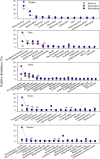Predominant Microbial Colonizers in the Root Endosphere and Rhizosphere of Turfgrass Systems: Pseudomonas veronii, Janthinobacterium lividum, and Pseudogymnoascus spp
- PMID: 33833744
- PMCID: PMC8021697
- DOI: 10.3389/fmicb.2021.643904
Predominant Microbial Colonizers in the Root Endosphere and Rhizosphere of Turfgrass Systems: Pseudomonas veronii, Janthinobacterium lividum, and Pseudogymnoascus spp
Abstract
Microbes can colonize plant roots to modulate plant health and environmental fitness. Thus, using microbes to improve plant adaptation to biotic and abiotic stresses will be promising to abate the heavy reliance of management systems on synthetic chemicals and limited resource. This is particularly important for turfgrass systems because intensive management for plant available nutrients (e.g., nitrogen), water, and pest control is necessary to maintain a healthy and aesthetic landscape. However, little is known on microbial species and host compatibility in turfgrass root endosphere and rhizosphere. Here, by using marker gene high throughput sequencing approaches we demonstrated that a few bacterial and fungal species prevailed the root endosphere and rhizosphere and were of a broad host spectrum. Irrespective of turfgrass species (bermudagrass, ultradwarf bermudagrass, creeping bentgrass, and tall fescue), defoliation intensities (i.e., mowing height and frequency), turfgrass sites, and sampling time, Pseudomonas veronii was predominant in the root endosphere, constituting ∼38% of the total bacterial community, which was much higher than its presence in the bulk soil (∼0.5%) and rhizosphere (∼4.6%). By contrast, Janthinobacterium lividum and fungal species of the genus Pseudogymnoascus were more abundant in the rhizosphere, constituting ∼15 and ∼ 39% of the total bacterial and fungal community, respectively, compared to their respective presence in the bulk soil (∼ 0.1 and 5%) and root endosphere (∼ 0.8 and 0.3%). Such stark contrasts in the microbiome composition between the root endosphere, rhizosphere, and bulk soil were little influenced by turfgrass species, suggesting the broad turfgrass host compatibility of these bacterial and fungal species. Further, their dominance in respective niches were mutually unaffected, implying the possibility of developing a multiple species formula for coping turfgrass with environmental stresses. These species were likely involved in controlling pests, such as infectious nematodes and fungi, decomposing root debris, and helping turfgrass water and nutrient uptake; yet these possibilities need to be further examined.
Keywords: Pseudomonas; endophytes; microbiome; rhizosphere; turfgrass.
Copyright © 2021 Xia, Rufty and Shi.
Conflict of interest statement
The authors declare that the research was conducted in the absence of any commercial or financial relationships that could be construed as a potential conflict of interest.
Figures





Similar articles
-
Foot traffic on turf primarily shaped the endophytic bacteriome of the soil-rhizosphere-root continuum.Front Microbiol. 2025 Apr 9;16:1488371. doi: 10.3389/fmicb.2025.1488371. eCollection 2025. Front Microbiol. 2025. PMID: 40270828 Free PMC article.
-
Epichloë Endophyte Infection Changes the Root Endosphere Microbial Community Composition of Leymus Chinensis Under Both Potted and Field Growth Conditions.Microb Ecol. 2023 Feb;85(2):604-616. doi: 10.1007/s00248-022-01983-0. Epub 2022 Feb 23. Microb Ecol. 2023. PMID: 35194659
-
Root Niches of Blueberry Imprint Increasing Bacterial-Fungal Interkingdom Interactions along the Soil-Rhizosphere-Root Continuum.Microbiol Spectr. 2023 Jun 15;11(3):e0533322. doi: 10.1128/spectrum.05333-22. Epub 2023 May 24. Microbiol Spectr. 2023. PMID: 37222589 Free PMC article.
-
The Role of Host Genetic Signatures on Root-Microbe Interactions in the Rhizosphere and Endosphere.Front Plant Sci. 2018 Dec 19;9:1896. doi: 10.3389/fpls.2018.01896. eCollection 2018. Front Plant Sci. 2018. PMID: 30619438 Free PMC article. Review.
-
Insect pathogens as biological control agents: Back to the future.J Invertebr Pathol. 2015 Nov;132:1-41. doi: 10.1016/j.jip.2015.07.009. Epub 2015 Jul 27. J Invertebr Pathol. 2015. PMID: 26225455 Review.
Cited by
-
Characteristics of Fungal Communities in Red Mud/Phosphogypsum-Based Artificial Soils.Biology (Basel). 2025 Mar 11;14(3):285. doi: 10.3390/biology14030285. Biology (Basel). 2025. PMID: 40136542 Free PMC article.
-
Variability of microbiomes in winter rye, wheat, and triticale affected by snow mold: predicting promising microorganisms for the disease control.Environ Microbiome. 2025 Jan 11;20(1):3. doi: 10.1186/s40793-025-00665-x. Environ Microbiome. 2025. PMID: 39799378 Free PMC article.
-
Abundance, diversity, and composition of root-associated microbial communities varied with tall fescue cultivars under water deficit.Front Microbiol. 2023 Jan 12;13:1078836. doi: 10.3389/fmicb.2022.1078836. eCollection 2022. Front Microbiol. 2023. PMID: 36713160 Free PMC article.
-
Foot traffic on turf primarily shaped the endophytic bacteriome of the soil-rhizosphere-root continuum.Front Microbiol. 2025 Apr 9;16:1488371. doi: 10.3389/fmicb.2025.1488371. eCollection 2025. Front Microbiol. 2025. PMID: 40270828 Free PMC article.
-
Genotypic Identification of Trees Using DNA Barcodes and Microbiome Analysis of Rhizosphere Microbial Communities.Genes (Basel). 2024 Jul 1;15(7):865. doi: 10.3390/genes15070865. Genes (Basel). 2024. PMID: 39062644 Free PMC article.
References
-
- Ansary M. H., Rahmani H. A., Ardakani M. R., Paknejad F., Mafakheri S. (2012). Effect of Pseudomonas fluorescent on proline and phytohormonal status of maize (Zea mays L.) under water deficit stress. Ann. Biol. Res. 3 1054–1062.
-
- Baca B. E., Elmerich C. (2007). “Microbial production of plant hormones,” in Associative and Endophytic Nitrogen-fixing Bacteria and Cyanobacterial Associations, eds Elmerich C., Newton W. E. (New York, NY: Springer; ), 113–143.
LinkOut - more resources
Full Text Sources
Other Literature Sources
Miscellaneous

